heating MAZDA MODEL TRIBUTE 2008 Owners Manual (in English)
[x] Cancel search | Manufacturer: MAZDA, Model Year: 2008, Model line: MODEL TRIBUTE, Model: MAZDA MODEL TRIBUTE 2008Pages: 288, PDF Size: 3.9 MB
Page 1 of 288

Introduction 4
Instrument Cluster 12
Warning lights and chimes 12
Gauges 17
Entertainment Systems 19
Auxiliary input jack 25
Climate Controls 29
Manual heating and air conditioning 29
Rear window defroster 31
Lights 32
Headlamps 32
Turn signal control 35
Bulb replacement 36
Driver Controls 42
Windshield wiper/washer control 42
Steering wheel adjustment 43
Power windows 47
Mirrors 48
Cruise control 49
Moon roof 53
Locks and Security 60
Keys 60
Locks 62
Anti-theft system 68
Seating and Safety Restraints 72
Seating 72
Safety restraints 81
Airbags 97
Child restraints 113
Table of Contents
1
2008 Tribute (j14)
Owners Guide (post-2002-fmt)
USA (fus)
Page 2 of 288
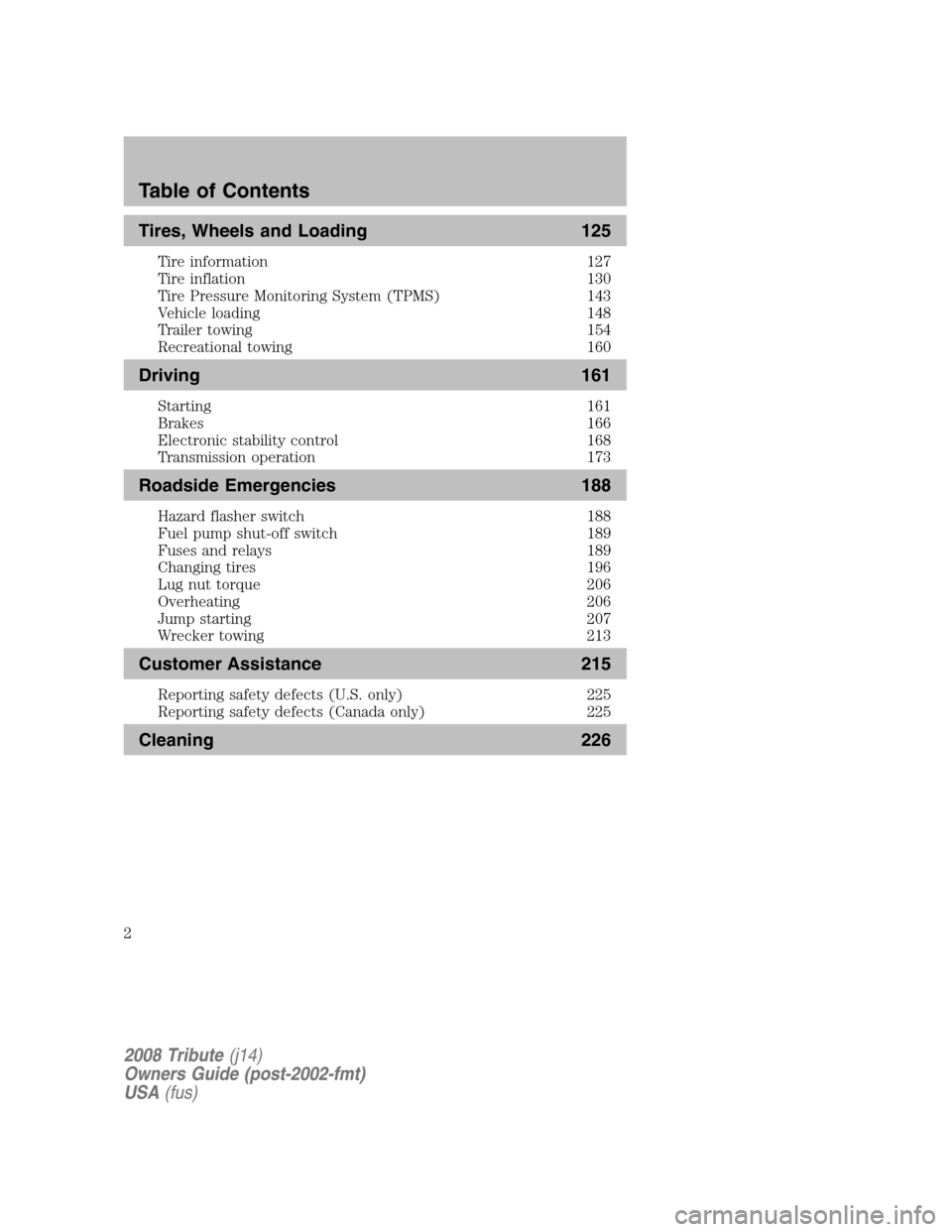
Tires, Wheels and Loading 125
Tire information 127
Tire inflation 130
Tire Pressure Monitoring System (TPMS) 143
Vehicle loading 148
Trailer towing 154
Recreational towing 160
Driving 161
Starting 161
Brakes 166
Electronic stability control 168
Transmission operation 173
Roadside Emergencies 188
Hazard flasher switch 188
Fuel pump shut-off switch 189
Fuses and relays 189
Changing tires 196
Lug nut torque 206
Overheating 206
Jump starting 207
Wrecker towing 213
Customer Assistance 215
Reporting safety defects (U.S. only) 225
Reporting safety defects (Canada only) 225
Cleaning 226
Table of Contents
2
2008 Tribute (j14)
Owners Guide (post-2002-fmt)
USA (fus)
Page 17 of 288

GAUGES
Speedometer: Indicates the
current vehicle speed.
Engine coolant temperature
gauge: Indicates engine coolant
temperature. At normal operating
temperature, the needle will be in
the normal range (between “H” and
“C”). If it enters the red section,
the engine is overheating. Stop
the vehicle as soon as safely
possible, switch off the engine and let the engine cool.
WARNING: When the engine and radiator are hot, scalding
coolant and steam may shoot out under pressure and cause
serious injury. Do not remove the cooling system cap when the
engine and radiator are hot.
2008 Tribute (j14)
Owners Guide (post-2002-fmt)
USA (fus)
Instrument Cluster
17
Page 29 of 288
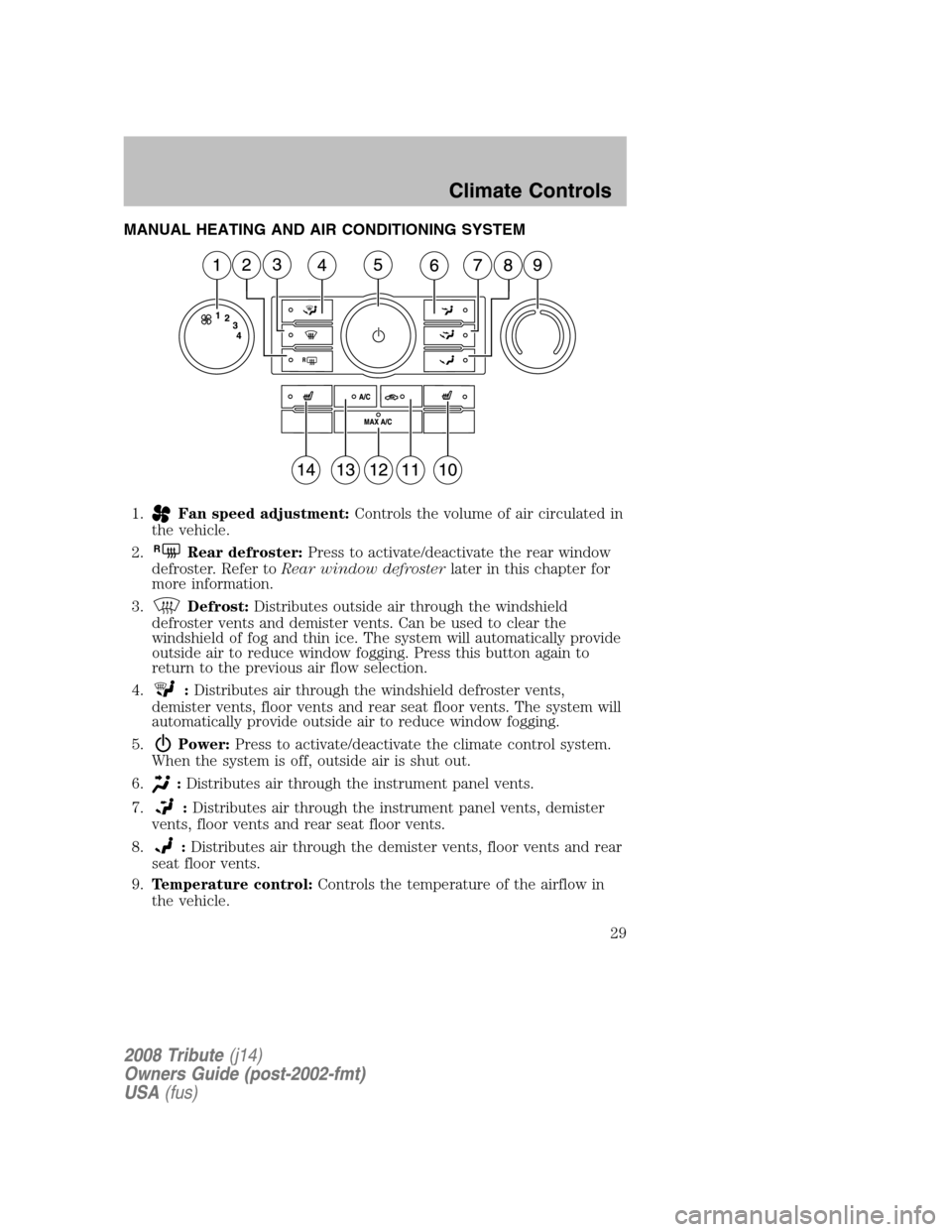
MANUAL HEATING AND AIR CONDITIONING SYSTEM 1.
Fan speed adjustment: Controls the volume of air circulated in
the vehicle.
2.
RRear defroster: Press to activate/deactivate the rear window
defroster. Refer to Rear window defroster later in this chapter for
more information.
3.
Defrost: Distributes outside air through the windshield
defroster vents and demister vents. Can be used to clear the
windshield of fog and thin ice. The system will automatically provide
outside air to reduce window fogging. Press this button again to
return to the previous air flow selection.
4.
: Distributes air through the windshield defroster vents,
demister vents, floor vents and rear seat floor vents. The system will
automatically provide outside air to reduce window fogging.
5.
Power: Press to activate/deactivate the climate control system.
When the system is off, outside air is shut out.
6.
: Distributes air through the instrument panel vents.
7.
: Distributes air through the instrument panel vents, demister
vents, floor vents and rear seat floor vents.
8.
: Distributes air through the demister vents, floor vents and rear
seat floor vents.
9. Temperature control: Controls the temperature of the airflow in
the vehicle.
2008 Tribute (j14)
Owners Guide (post-2002-fmt)
USA (fus)
Climate Controls
29
Page 46 of 288
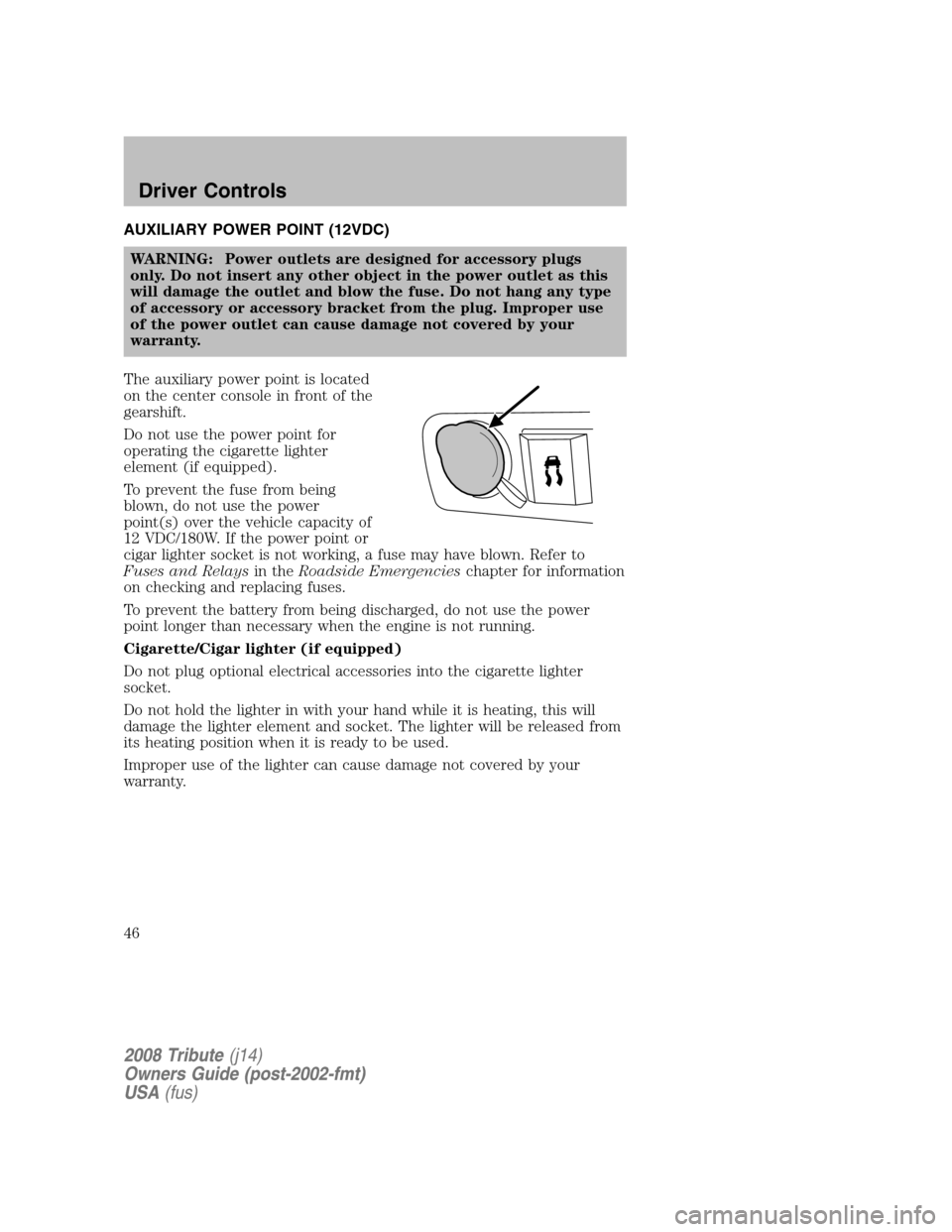
AUXILIARY POWER POINT (12VDC) WARNING: Power outlets are designed for accessory plugs
only. Do not insert any other object in the power outlet as this
will damage the outlet and blow the fuse. Do not hang any type
of accessory or accessory bracket from the plug. Improper use
of the power outlet can cause damage not covered by your
warranty.
The auxiliary power point is located
on the center console in front of the
gearshift.
Do not use the power point for
operating the cigarette lighter
element (if equipped).
To prevent the fuse from being
blown, do not use the power
point(s) over the vehicle capacity of
12 VDC/180W. If the power point or
cigar lighter socket is not working, a fuse may have blown. Refer to
Fuses and Relays in theRoadside Emergencies chapter for information
on checking and replacing fuses.
To prevent the battery from being discharged, do not use the power
point longer than necessary when the engine is not running.
Cigarette/Cigar lighter (if equipped)
Do not plug optional electrical accessories into the cigarette lighter
socket.
Do not hold the lighter in with your hand while it is heating, this will
damage the lighter element and socket. The lighter will be released from
its heating position when it is ready to be used.
Improper use of the lighter can cause damage not covered by your
warranty.
2008 Tribute (j14)
Owners Guide (post-2002-fmt)
USA (fus)
Driver Controls
46
Page 165 of 288
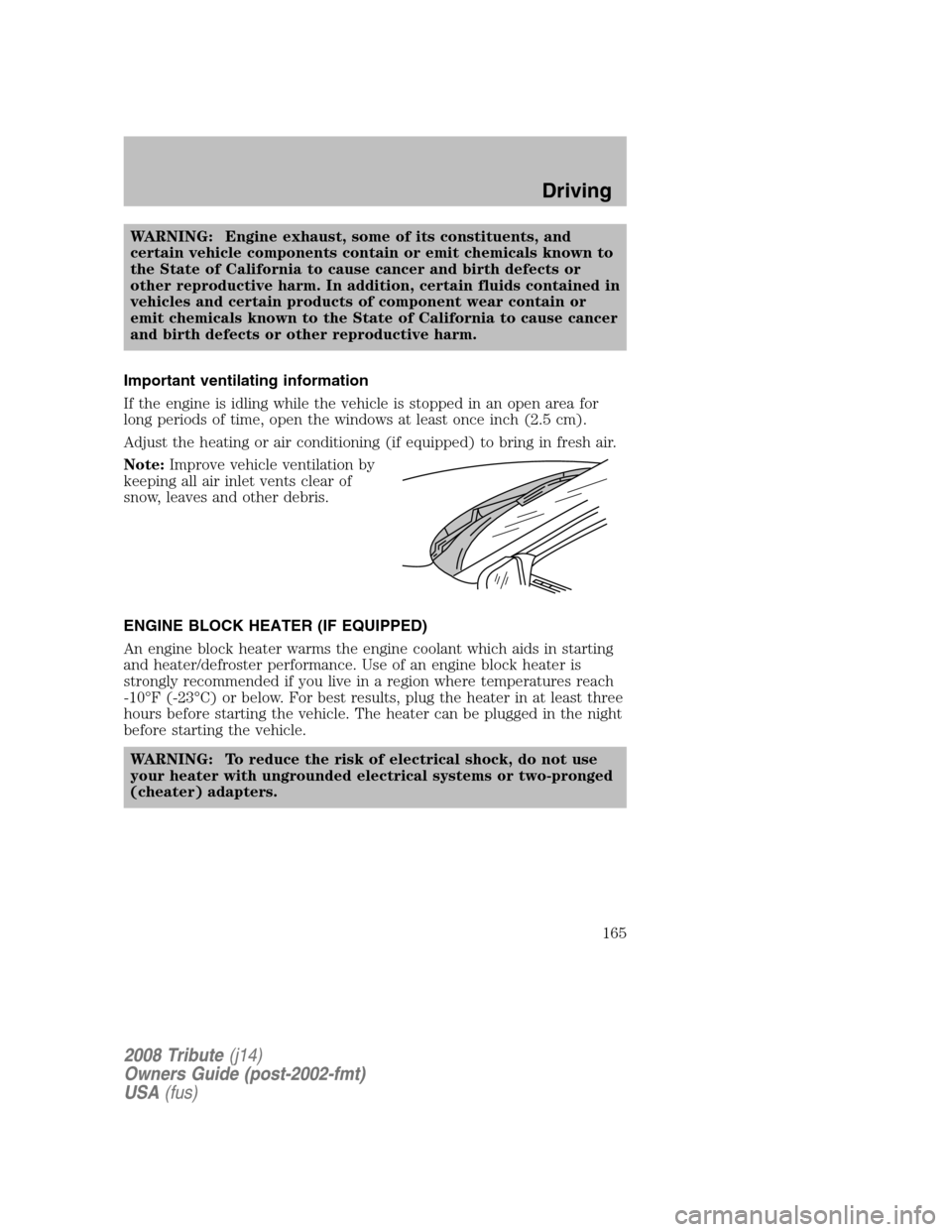
WARNING: Engine exhaust, some of its constituents, and
certain vehicle components contain or emit chemicals known to
the State of California to cause cancer and birth defects or
other reproductive harm. In addition, certain fluids contained in
vehicles and certain products of component wear contain or
emit chemicals known to the State of California to cause cancer
and birth defects or other reproductive harm.
Important ventilating information
If the engine is idling while the vehicle is stopped in an open area for
long periods of time, open the windows at least once inch (2.5 cm).
Adjust the heating or air conditioning (if equipped) to bring in fresh air.
Note: Improve vehicle ventilation by
keeping all air inlet vents clear of
snow, leaves and other debris.
ENGINE BLOCK HEATER (IF EQUIPPED)
An engine block heater warms the engine coolant which aids in starting
and heater/defroster performance. Use of an engine block heater is
strongly recommended if you live in a region where temperatures reach
-10°F (-23°C) or below. For best results, plug the heater in at least three
hours before starting the vehicle. The heater can be plugged in the night
before starting the vehicle.
WARNING: To reduce the risk of electrical shock, do not use
your heater with ungrounded electrical systems or two-pronged
(cheater) adapters.
2008 Tribute (j14)
Owners Guide (post-2002-fmt)
USA (fus)
Driving
165
Page 172 of 288

WARNING: Aggressive driving in any road conditions can cause
you to lose control of your vehicle increasing the risk of severe
personal injury or property damage. The occurrence of a
Electronic Stability Control (ESC) event is an indication that
at least some of the tires have exceeded their ability to grip the
road; this may lead to an increased risk of loss of vehicle
control, vehicle rollover, personal injury and death. If you
experience a severe road event, SLOW DOWN.
If a failure is detected in the ESC system, and the ESC button has not
been pushed, the warning indicator light in the instrument cluster will
stay on. If the warning indicator light in the instrument cluster remains
on while the engine is running, have the system serviced by an
authorized dealer immediately.
STEERING
Your vehicle is equipped with an Electric Power-Assisted Steering
(EPAS) system. There is no fluid reservoir to check or fill.
If your vehicle loses electrical power while you are driving (or if the
ignition is turned off), you can steer the vehicle manually, but it takes
more effort. Under extreme usage conditions, the steering effort may
increase. This occurs to prevent overheating and permanent damage to
your steering system. If this should occur, you will neither lose the ability
to steer the vehicle manually nor will it cause permanent damage.
Typical steering and driving maneuvers will allow the system to cool and
steering assist will return to normal.
If the steering wanders or pulls, check for:
• an improperly inflated tire
• uneven tire wear
• loose or worn suspension components
• loose or worn steering components
• improper steering alignment
A high crown in the road or high crosswinds may also make the steering
seem to wander/pull.
2008 Tribute (j14)
Owners Guide (post-2002-fmt)
USA (fus)
Driving
172
Page 186 of 288
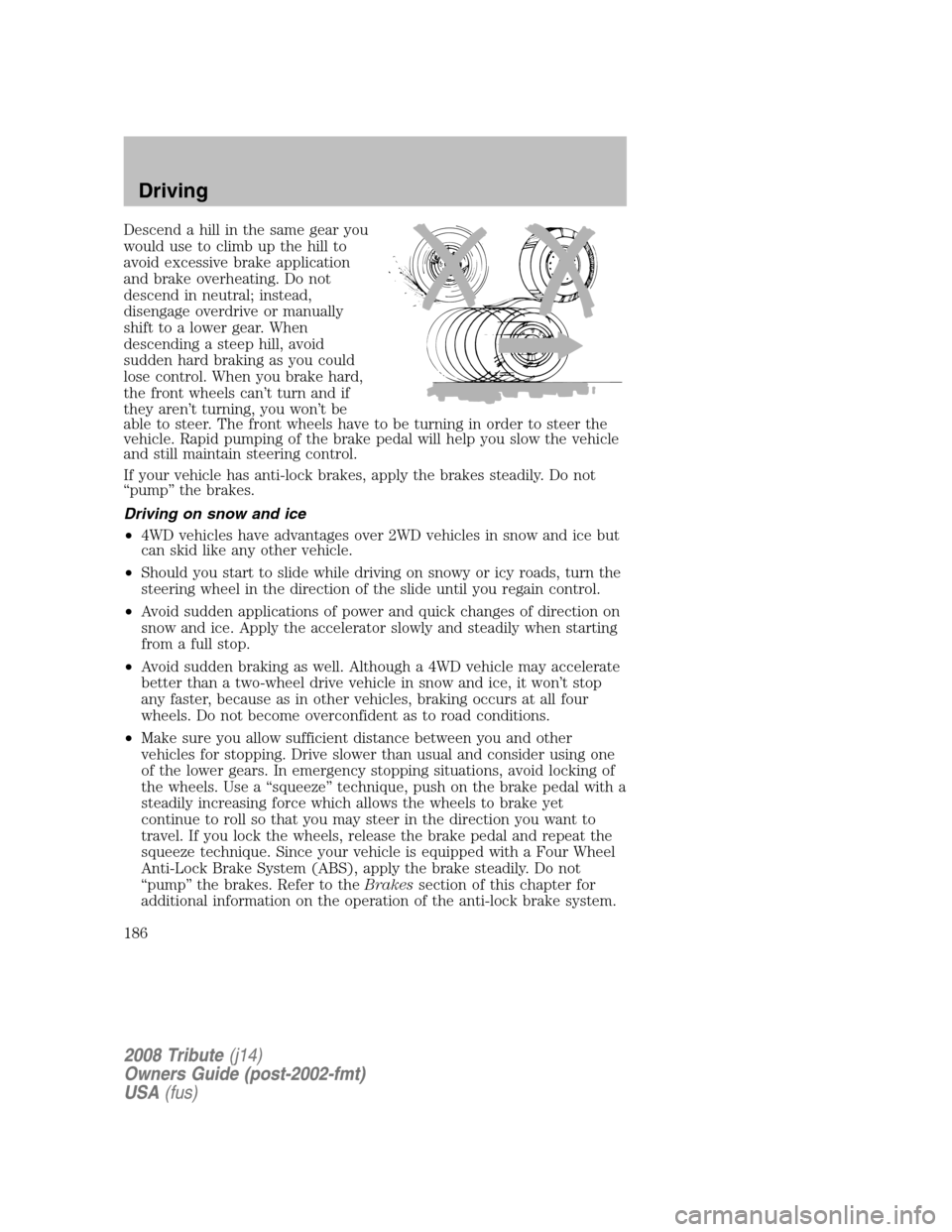
Descend a hill in the same gear you
would use to climb up the hill to
avoid excessive brake application
and brake overheating. Do not
descend in neutral; instead,
disengage overdrive or manually
shift to a lower gear. When
descending a steep hill, avoid
sudden hard braking as you could
lose control. When you brake hard,
the front wheels can’t turn and if
they aren’t turning, you won’t be
able to steer. The front wheels have to be turning in order to steer the
vehicle. Rapid pumping of the brake pedal will help you slow the vehicle
and still maintain steering control.
If your vehicle has anti-lock brakes, apply the brakes steadily. Do not
“pump” the brakes.
Driving on snow and ice
• 4WD vehicles have advantages over 2WD vehicles in snow and ice but
can skid like any other vehicle.
• Should you start to slide while driving on snowy or icy roads, turn the
steering wheel in the direction of the slide until you regain control.
• Avoid sudden applications of power and quick changes of direction on
snow and ice. Apply the accelerator slowly and steadily when starting
from a full stop.
• Avoid sudden braking as well. Although a 4WD vehicle may accelerate
better than a two-wheel drive vehicle in snow and ice, it won’t stop
any faster, because as in other vehicles, braking occurs at all four
wheels. Do not become overconfident as to road conditions.
• Make sure you allow sufficient distance between you and other
vehicles for stopping. Drive slower than usual and consider using one
of the lower gears. In emergency stopping situations, avoid locking of
the wheels. Use a “squeeze” technique, push on the brake pedal with a
steadily increasing force which allows the wheels to brake yet
continue to roll so that you may steer in the direction you want to
travel. If you lock the wheels, release the brake pedal and repeat the
squeeze technique. Since your vehicle is equipped with a Four Wheel
Anti-Lock Brake System (ABS), apply the brake steadily. Do not
“pump” the brakes. Refer to the Brakessection of this chapter for
additional information on the operation of the anti-lock brake system.
2008 Tribute (j14)
Owners Guide (post-2002-fmt)
USA (fus)
Driving
186
Page 206 of 288

7. Repeat this tightness check procedure when servicing the spare tire pressure (every six months), or at any time that the spare tire is
disturbed through service of other components.
WHEEL LUG NUT TORQUE SPECIFICATIONS
Retighten the lug nuts to the specified torque at 500 miles (800 km)
after any wheel disturbance (tire rotation, changing a flat tire, wheel
removal, etc.).
Bolt size Wheel lug nut torque* lb.ft. N •m
M12 x 1.5 100 135
* Torque specifications are for nut and bolt threads free of dirt and
rust. Use only Mazda recommended replacement fasteners.
WARNING: When a wheel is installed, always remove any
corrosion, dirt or foreign materials present on the mounting
surfaces of the wheel or the surface of the wheel hub, brake
drum or brake disc that contacts the wheel. Ensure that any
fasteners that attach the rotor to the hub are secured so they
do not interfere with the mounting surfaces of the wheel.
Installing wheels without correct metal-to-metal contact at the
wheel mounting surfaces can cause the wheel nuts to loosen
and the wheel to come off while the vehicle is in motion,
resulting in loss of control.
OVERHEATING
If the temperature gauge indicates overheating and you experience
power loss, you hear a loud knocking or pinging noise, the engine is
probably too hot.
If this happens: 1. Drive safely to the side of the road and park off the right-of-way.
2. Shift the automatic transmission into P (Park) or the manual transmission into the neutral position, and apply the parking brake.
3. Turn off the air conditioner.
WARNING: Steam from an overheated engine is dangerous. The
escaping steam could seriously burn you. Open the hood ONLY
after steam is no longer escaping from the engine.
2008 Tribute (j14)
Owners Guide (post-2002-fmt)
USA (fus)
Roadside Emergencies
206
Page 252 of 288

•DO NOT MIX recycled coolant and conventional coolant
together in your vehicle. Mixing of engine coolants may harm
your engine’s cooling system.
• The use of an improper coolant may harm engine and cooling
system components and may void the warranty of your vehicle’s
engine cooling system. If you are unsure which type of coolant
your vehicle requires, contact your local authorized dealer.
WARNING: Do not put engine coolant in the windshield washer
fluid reservoir. If engine coolant is sprayed onto the windshield,
it could make it difficult to see through the windshield.
When adding coolant, make sure it is a 50/50 mixture of engine coolant
and distilled water. Add the mixture to the coolant reservoir, when the
engine is cool , until the appropriate fill level is obtained.
• NEVER increase the coolant concentration above 60%.
• NEVER decrease the coolant concentration below 40%.
• Engine coolant concentrations above 60% or below 40% will
decrease the freeze protection characteristics of the engine
coolant and may cause engine damage.
A large amount of water without engine coolant may be added, in case of
emergency, to reach a vehicle service location. In this instance, the
cooling system must be drained and refilled with a 50/50 mixture of
engine coolant and distilled water as soon as possible. Water alone
(without engine coolant) can cause engine damage from corrosion,
overheating or freezing.
For vehicles with overflow coolant systems with a non-pressurized cap
on the coolant recovery system, add coolant to the coolant recovery
reservoir when the engine is cool. Add the proper mixture of coolant and
water to the “COLD FILL RANGE”. For all other vehicles, which have a
coolant degas system with a pressurized cap, or if it is necessary to
remove the coolant pressure relief cap on the radiator of a vehicle with
an overflow system, follow these steps to add engine coolant.
Note: For the 2.3L engine, when adding more than 1 quart (.95L) of
coolant it is necessary to use the coolant bleed valve. Failure to bleed
the cooling system when adding engine coolant may cause engine
damage. Refer to the Cooling section of the Workshop Manual.
2008 Tribute(j14)
Owners Guide (post-2002-fmt)
USA (fus)
Maintenance and Specifications
252